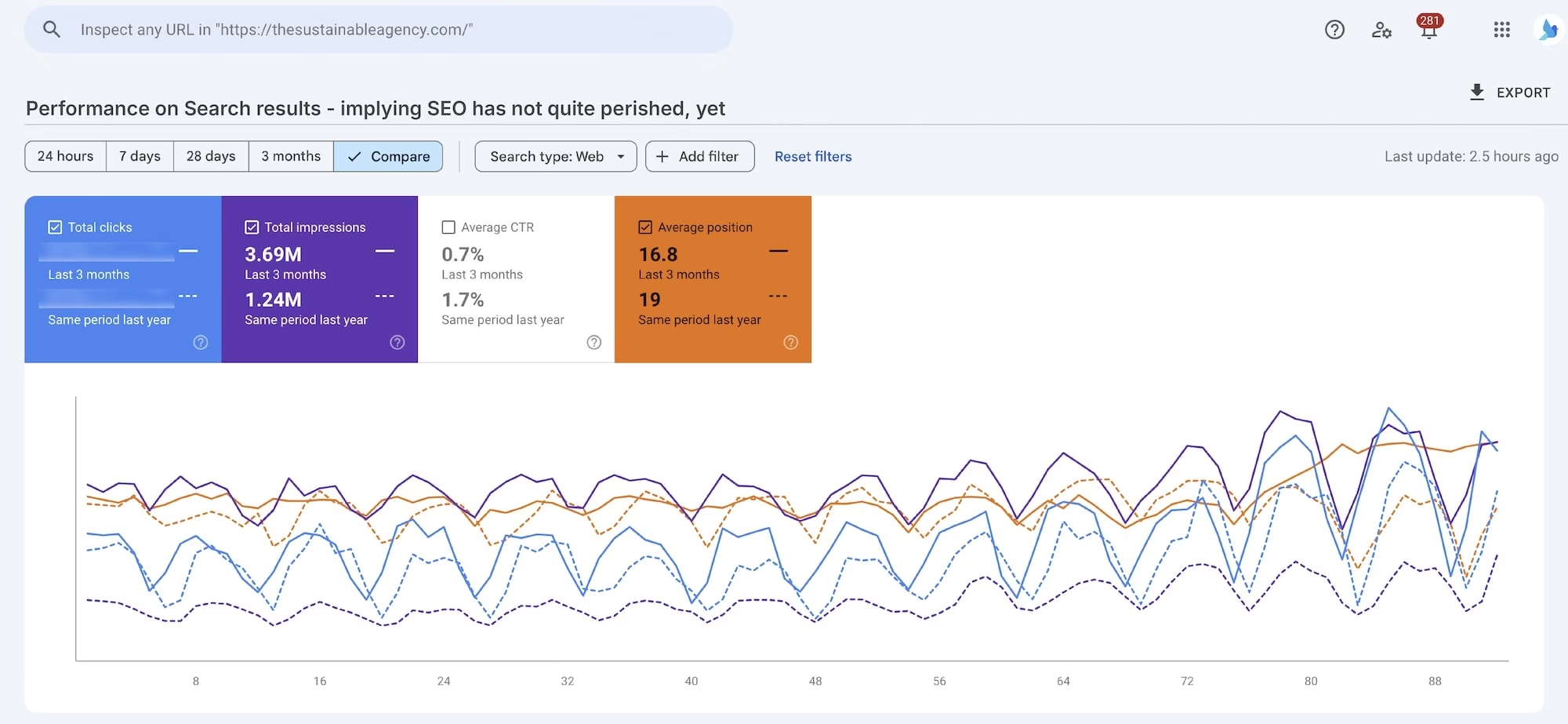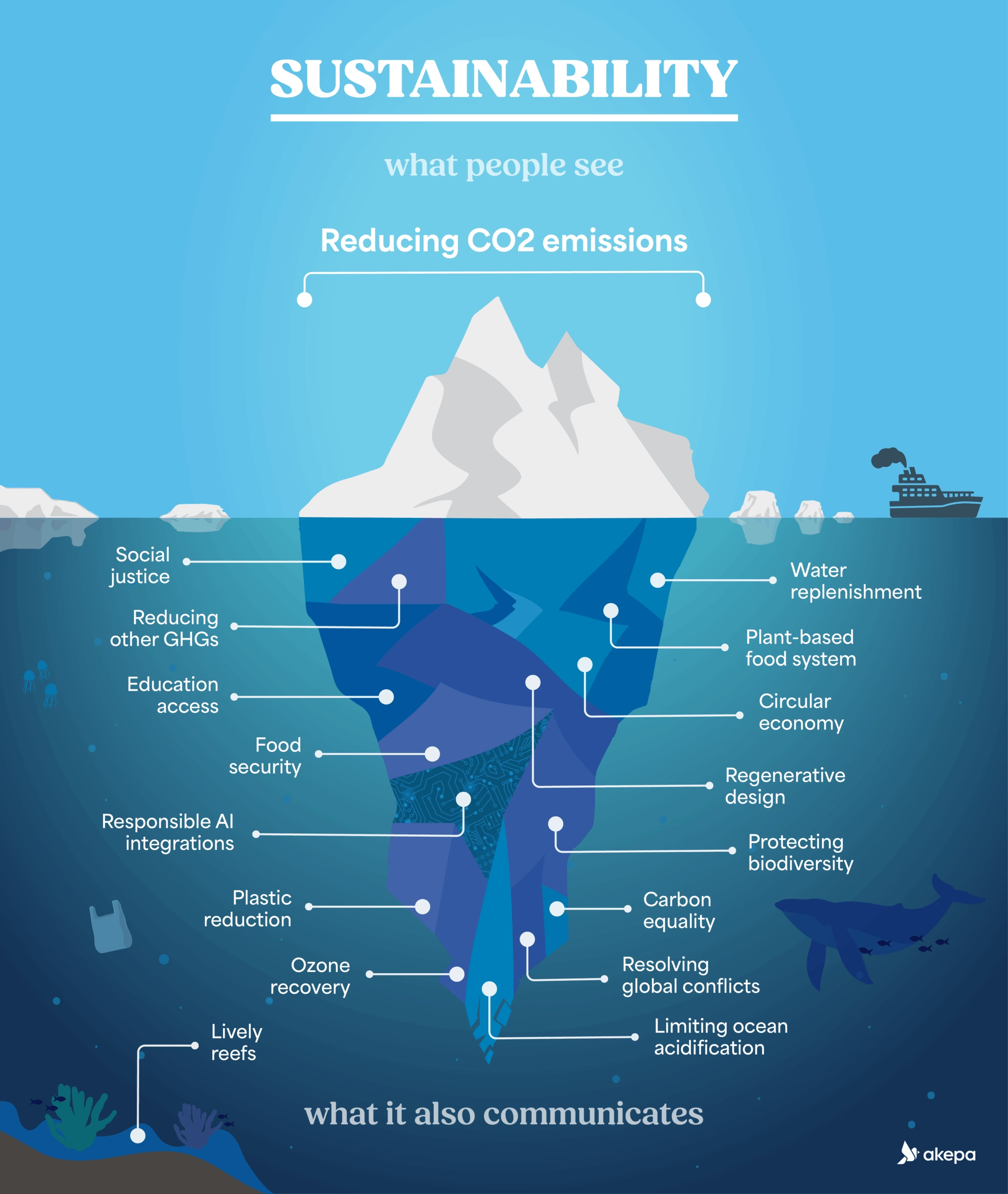You’ve heard the gossip, haven’t you? That hushed chorus of schadenfreude, floating around the internet: “SEO is dead.”
They say AI chatbots and Google’s own Generative Search Experience (GSE) have stolen all the clicks. That soon, nobody will ever scroll past the first answer box and the organic traffic stream will run dry, at last.
Well, here at Akepa, we’re not just hearing the gossip – we’re comparing those claims against reality.
And what are we seeing? The exact opposite.
On our site and across our client portfolio, organic SEO traffic is up enormously year-on-year. We’re talking rankings, impressions, clicks. The lot.

In fact, something else is happening: SEO and AI traffic are co-existing in harmony, like cyber-man and his cyber-dog. The traditional traffic from the blue links is combining with newfangled traffic from the AI answer boxes to take website visitors to new heights.
No fisticuffs. A glow up. It’s a landscape where the fundamentals of great content are more important than ever. The old, spammy tricks are out. The human element is right on-trend, as it always should have been.
So, how do you make sure your website is maximising, not just surviving?
Here are seven strategies we follow to keep the organic floodgates open in the age of AI.
Seven strategies to AI-proof your SEO
1. Don’t get distracted by gobbledygook. Just create great content.
Don’t get paralyzed by the new jargon. It’s even worse than the old jargon.
“Chunking” “Answer Engine Optimization.” “Semantic Vector Space.” “Hallucination Mitigation.”
Well, it might all sound impressively geeky but if you strip it back, the core truth of the internet hasn’t changed: people want great stuff to read and watch. Or if not great, then something that moves them in some way.
A clever technical trick may get you a temporary bump. But great, helpful, human-written content will build you long-term authority. Search engines, AI models, and, most importantly, the actual People reading your work – they all reward quality. If it doesn’t serve a person, it won’t serve any algorithm with a shred of sophistication for long.
2. Avoid writing articles from scratch using AI.
You have read such slop.
And maybe you’ve created some of your own slop by pasting a prompt into a chatbot to retrieve a flawlessly shaped, absolutely flavourless 1,500-word dollop.
That’s convenient when it doesn’t feel like you have much time but it won’t get you traffic. Because the internet is now saturated with that stuff. It reads like it went travelling in a vending machine, so it will be treated like a commodity and commodities don’t rank.
Our tip: If you do use AI for drafting or research, edit the content heavily to inject personal stories, original insights, and personality. Make it something that AI couldn’t possibly generate because it’s in a tone of voice that’s uniquely yours – with stories and skin to match.
3. Shun the scientific. AI has that covered.
AI chatbots are fantastic at one thing: the didactic diatribe.
They can perfectly explain the history of your industry, the chemical reaction in a volcano, or the precise definition of a 308 redirect. They are the ultimate, encyclopaedic textbook that is endless in its scope but can be instantly navigated.
The problem for your website now is, nobody clicks a link just to get the textbook definition anymore. They ask the chatbot. And, crucially, they trust the chatbot.
To merit the click, you must offer something more than facts. Offer an off-beat opinion. Offer an entertaining case study. Deliver an unsolicited hot take without offering. Swear. Be the exciting new kid in class, not the teacher. That shift from what something is to what we think about it.
That is what you are now trusted with. Not with the linear facts. But the messy interpretation.
4. Create content consistently.
We know. Sometimes you don’t feel like writing a blog post. It’s so easy to lose momentum and then there’s a tricky amount of inertia to get going again.
Bad idea. Don’t procrastinate.
The internet’s engines – both human and AI – reward rhythm and momentum. Getting into a regular writing rhythm is more beneficial than any flash-in-the-pan viral hit. It builds topical authority, keeps search engine crawlers refreshed, and means you don’t have to wearily announce “we’re serious about this!”. Think of it like going to the gym: a consistent, moderate effort beats an exhausting knee-shattering sprint every time.
5. Stop doing spammy sh*t.
SEO might not be dead but let’s be clear: spammy sh*t is dead.
That includes the classic, awkward keyword stuffing that makes sentences unreadable. Or link-building schemes with low-quality, random domains. We could go on and on but it includes any manipulative tactic designed to trick a machine instead of help a person.
Modern SEO algorithms are smarter than ever and AI models feeding off the internet are even better at sniffing out garbage. This doesn’t work for modern SEO, and it absolutely doesn’t work in the age of AI, either. We repeat: do not waste your time trying to game a system that is now focused on quality. Or if we were to put our geeky SEO hats on we’d say E-E-A-T (Experience, Expertise, Authoritativeness, and Trustworthiness).
6. Go back and improve your best.
You have a few fillers on your site but you also have some absolute bangers. They get great traffic, maybe they snagged a high-value keyword, or they just pop on social feeds.
Whatever it is makes them good. Those are your gold mines.
So why are such articles so often overlooked? Don’t just leave them to rot. Updating and improving your best-performing content is just as valuable as creating new content (if not more so).
That’s why at Akepa we’re constantly in the process of updating and republishing our best articles like our exhaustive list of greenwashing examples. We’re at that task every single month besides writing new posts.
So, like us, go back, update the facts, add the new AI context, inject fresh screenshots to replace the confusing old ones, and republish. This sends a signal to search engines that your content is fresh, authoritative, and a definitive resource on the topic.
Would you spend much time in a garden that was beautiful but has grown into disrepair, despite some hasty new shrubbery along some fringe pathways?
7. Cultivate a rare mix of words and visuals.
Look out of the window (meaning: go on Linkedin for a bit), there are so many wordsmiths out there. The barriers to entry have lowered. Everyone can write. It wasn’t like this that long ago.
It’s true that AI writing, in clumsy hands, is often embarrassing in its artificial sass. But standing out with neat words or grammar, a witty little turn of phrase here and there, is not possible now. Those times have gone, unless you really are an amazing writer.
So, besides all of the other advice we’ve given in this article, what else can you do to elevate yourself above the wall of competently expressed viewpoints, liberated from typos and broken sentences?
At Akepa, one of the main things we do to get the message across is create infographics to add to words, like the one we did below. Words and data visualization, combined, is still a rare skill.

How does that link with SEO? Because standing out gets you the links, likes, brand citations, and shares, that will boost your visibility in AI answers and SEO lists. Nothing weird.
SEO traffic decline isn’t inevitable. It’s a choice.
If you’re struggling with website traffic and believe that decline is just the inevitable cost of the AI zeitgeist, you are wrong.
The traffic is still out there. In fact, there’s potentially more of it now, split between traditional search and AI answers. The businesses winning today aren’t fighting the tide; they’re learning to kite-surf on it and enjoying the exalted view. They’re focusing on human-centric content that AIs cannot replicate.
Stop panicking about the future and start getting smart with the new fundamentals. If you’re ready to put the cyber-dog and cyber-man to work for your website and you need a team to sort out the strategy, give us a shout. We can work it out.



Leave a Reply